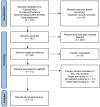Serum Brain-derived Neurotrophic Factor Levels as a Biomarker of Treatment Response in Patients With Depression: Systematic Review and Meta-analysis
- PMID: 40791036
- PMCID: PMC12353246
- DOI: 10.62641/aep.v53i4.1967
Serum Brain-derived Neurotrophic Factor Levels as a Biomarker of Treatment Response in Patients With Depression: Systematic Review and Meta-analysis
Abstract
Background: Brain-derived neurotrophic factor (BDNF) plays a key role in the pathophysiology of depression and the mechanism of action of antidepressants. This study aimed to evaluate the changes of BDNF in patients with depression and how it is affected by antidepressant treatment through meta-analysis.
Methods: Multiple databases (including PubMed, Embase and China National Knowledge Infrastructure (CNKI)) were searched for studies on BDNF levels in patients with depression published up to November 15, 2024. Meta-analyses of serum and plasma BDNF levels were performed using RevMan 5.4.1, with the effect sizes expressed as mean differences (MD) and 95% confidence intervals. Heterogeneity was assessed using I2 statistics (random-effects model if I2 ≥ 50%; fixed-effects if I2 < 50%).
Results: Serum BDNF levels in patients with depression were significantly lower than those in healthy controls [MD = -1.54, 95% confidence intervals (CI) (-2.85 to -0.24), p = 0.02]. Antidepressant drug treatment for 6 weeks significantly increased serum BDNF levels [MD = 7.42, 95% CI (1.10-13.74), p = 0.02], but the effect of 4 weeks of treatment was not statistically significant. Plasma BDNF levels showed no statistically significant differences between depressed patients and healthy controls (p > 0.05). Sensitivity analysis indicated that the meta-analysis results were robust and not unduly influenced by any single study.
Conclusion: Serum BDNF levels serve as potential biomarkers in patients with depression, but their sensitivity to short-term antidepressant treatment is limited.
Conflict of interest statement
The authors declare no conflict of interest.
Figures








Similar articles
-
Vortioxetine for depression in adults.Cochrane Database Syst Rev. 2017 Jul 5;7(7):CD011520. doi: 10.1002/14651858.CD011520.pub2. Cochrane Database Syst Rev. 2017. PMID: 28677828 Free PMC article.
-
Antidepressant treatment for postnatal depression.Cochrane Database Syst Rev. 2014 Sep 11;2014(9):CD002018. doi: 10.1002/14651858.CD002018.pub2. Cochrane Database Syst Rev. 2014. PMID: 25211400 Free PMC article.
-
Antidepressants for people with epilepsy and depression.Cochrane Database Syst Rev. 2014 Dec 3;2014(12):CD010682. doi: 10.1002/14651858.CD010682.pub2. Cochrane Database Syst Rev. 2014. Update in: Cochrane Database Syst Rev. 2021 Apr 16;4:CD010682. doi: 10.1002/14651858.CD010682.pub3. PMID: 25464360 Free PMC article. Updated.
-
Antidepressants for depression in adults with HIV infection.Cochrane Database Syst Rev. 2018 Jan 22;1(1):CD008525. doi: 10.1002/14651858.CD008525.pub3. Cochrane Database Syst Rev. 2018. PMID: 29355886 Free PMC article.
-
Psychological therapies for treatment-resistant depression in adults.Cochrane Database Syst Rev. 2018 May 14;5(5):CD010558. doi: 10.1002/14651858.CD010558.pub2. Cochrane Database Syst Rev. 2018. PMID: 29761488 Free PMC article.
References
-
- Karyotaki E, Efthimiou O, Miguel C, Bermpohl FMG, Furukawa TA, Cuijpers P, et al. Internet-Based Cognitive Behavioral Therapy for Depression: A Systematic Review and Individual Patient Data Network Meta-analysis. JAMA Psychiatry . 2021;78:361–371. doi: 10.1001/jamapsychiatry.2020.4364. - DOI - PMC - PubMed
Publication types
MeSH terms
Substances
LinkOut - more resources
Full Text Sources
Medical

